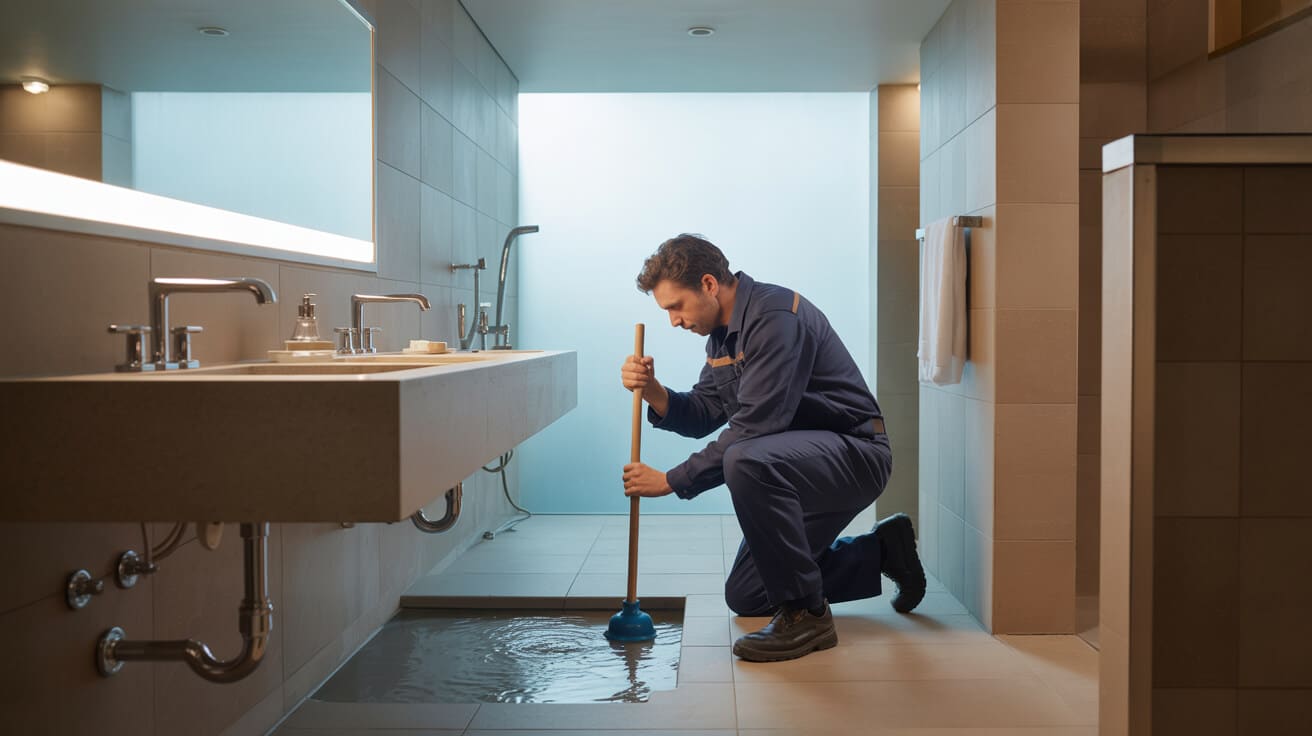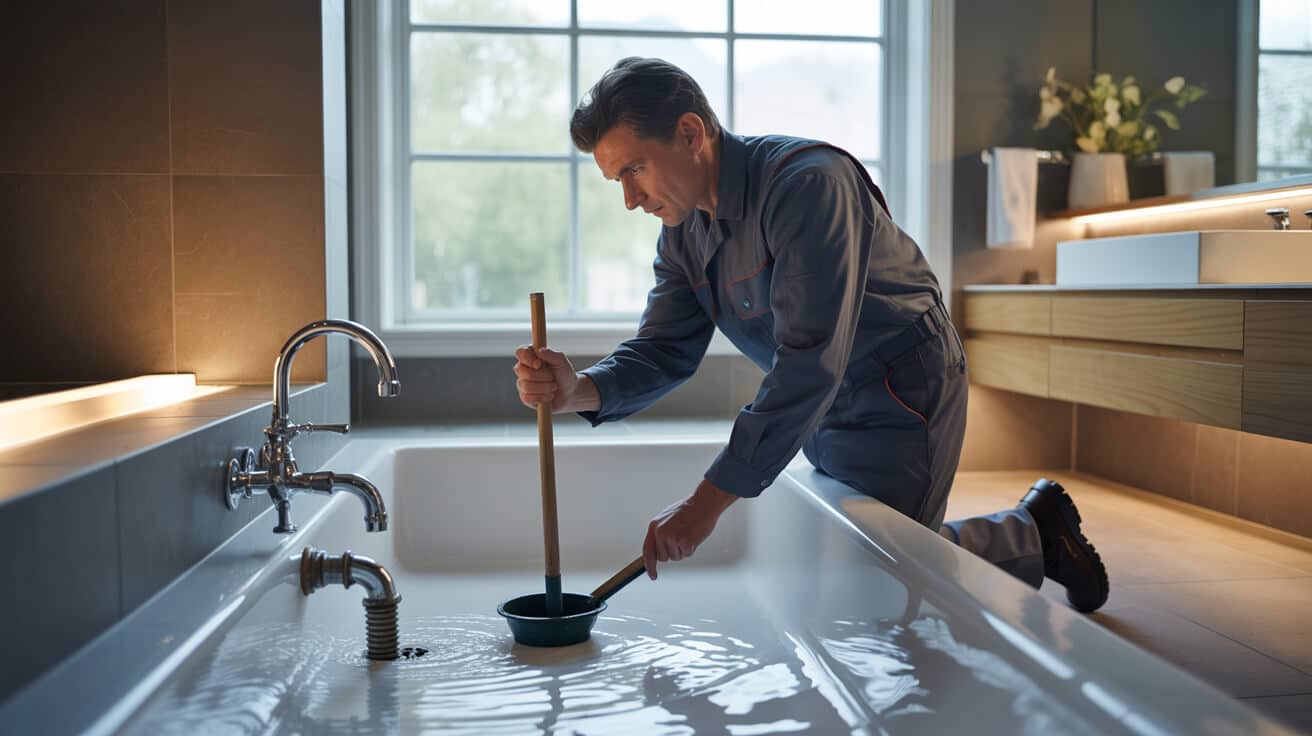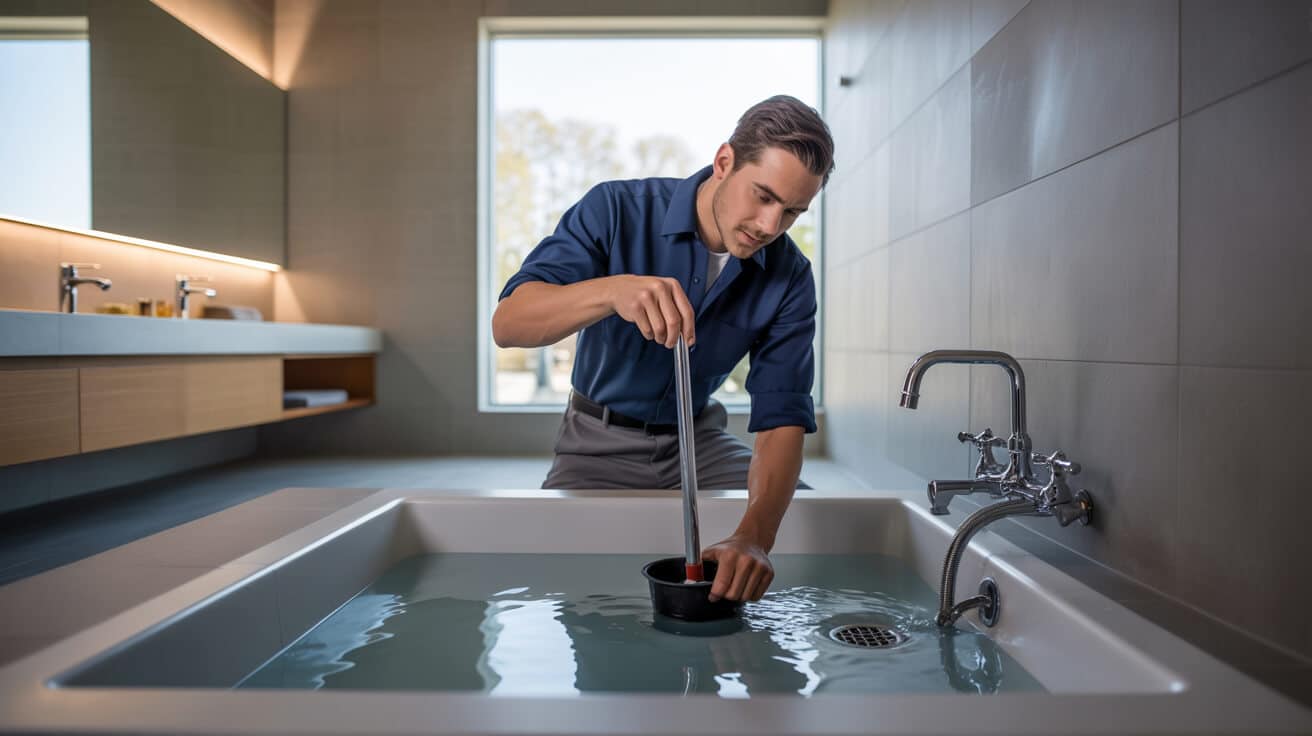blockages in sinks and baths originate from the daily confluence of organic matter, detergents, hair, soap scum, and—frequently—miscellaneous debris introduced through routine use or accidental disposal. The progression from minor slow draining to acute backup or flooding can be abrupt, challenging the resilience of both infrastructure and the routines of property occupants. Attention to modern best practices in blockage removal signals an understanding of not just immediate repair, but broader obligations regarding asset protection, hygiene, and the regulatory contract among landlords, tenants, and service providers.
Etymology or name origin
The word “blockage,” descended from Middle English, describes the act or result of stopping something’s normal flow. “Trap” in a plumbing context, adopted during early advancements in waste management, refers to a U-shaped, S-shaped, or bottlenecked pipe component designed to maintain a water seal after each use, thus blocking sewer gases. The evolution of terminology follows a historic trajectory that begins with open, unhygienic drains and matures into the lexicon of closed, code-compliant sanitary engineering.
Overview / context
Modern drainage design is orchestrated to rapidly and reliably evacuate wastewater from fixtures, preserving both hygiene and function across variable usage patterns. Sinks and baths serve as primary junctures between human activity and a property’s hidden network of pipes, traps, vents, and connections. Blockages occur at all property scales, interrupting not only the physical act of washing or cleaning, but also introducing psychological discomfort for users, operational headaches for maintenance teams, and insurance or regulatory complexity for property stewards. In multi-tenant, commercial, or managed portfolios, the emergence of a blockage moves beyond personal inconvenience, spotlighting the trust dynamic inherent in landlord-tenant and service provider relationships.
History
Origins and early solutions
Drainage management traces to the stone-lined channels of the Greeks and Romans, soluble only by frequent emptying and rudimentary manual clearing. Accumulation of debris in open or shared troughs created early public health hazards, establishing a pattern of reactive, rather than preventive, system maintenance.
Industrial-era advances
The 19th century witnessed mass adoption of traps, which reliably impeded sewer gases while allowing water and minor debris passage. Industrialisation brought the cast iron, then earthenware piping, followed by a dominance of copper, lead, and—in modern systems—purpose-designed plastics. Building codes emerged in parallel, codifying gradients, pipe sizes, and the formal requirement for maintenance access.
Contemporary evolution
Today, drainage networks are constructed to rigorous specifications. Building Regulations Part H in the United Kingdom, among other frameworks, prescribes system geometry, access points, and acceptable materials. Growing focus on environmental impact, including the hazards of chemical unblockers, drives innovation in both mechanical and biological removal solutions. The proliferation of inspection tools, from flexible cameras to traceable dye systems, further professionalises diagnosis and intervention.

Concept / description
Wastewater transit
A sink or bath typically routes water through a grid or pop-up waste outlet, into a trap configured to hold a static water seal, then into the horizontal or vertical waste branch. The pipework, properly pitched to harness gravity, channels wastewater to soil stacks or common drains, with vents regulating air balance and trap integrity.
Blockage formation
Debris enters traps and pipework every time a fixture is used. Hair and soap congeal, fats and oils solidify on cooler surfaces, and foreign objects quickly create partial or total obstruction—especially at sharp bends, joints, or under-sized runs. Pipework traversing long distances without sufficient gradient, or incorporating frequent direction changes, further predisposes toward build-up and stagnation.
Systemic responses
Blockage symptoms escalate: initial slow draining, trapped bubbles causing gurgling noises, odour from decaying organic matter, observable backing-up of water, and ultimately overflow or leakage at trap or pipe joint interfaces. Plumbing codes require built-in access at critical points, but user attempts to resolve issues may, without expertise or proper equipment, worsen constrictions or damage fixtures.
Functionality / purpose / applications
Restoring operational status
Blockage removal returns a fixture to normal operation, securing hygiene standards and reducing property risk. Within managed portfolios or commercial settings, rapid restoration functions as a reputational safeguard, reflecting on both the professionalism of the response and the embeddedness of maintenance protocols within your organisation.
Public health and property integrity
Standing water or frequent backup generates increased microbial activity, promoting pathogen growth and contributing to odour or pest problems. Moisture from persistent blockages undermines cabinetry, flooring, and adjacent wall systems, presenting hidden costs. Your attention to timely diagnosis and methodical resolution mitigates long-term downstream risks.
Application scope
Removal methodologies are employed at all scales: individual homeowners solving hair clogs in bathroom sinks, landlords responding to aggregated tenant reports, commercial managers enacting policy-based intervention, and professionals like Plumbers 4U executing high-skill, warranty-backed solutions.
Classifications / types / variants
By obstruction source
- Organic build-up: Hair, skin, food particles, and soap aggregate over time, more commonly in bathroom fixtures.
- FOG (fat, oil, grease): Predominant in kitchen-adjacent drains, often compounded by food waste and incorrect disposal practices.
- Foreign objects: Cotton buds, dental floss, and children’s toys in residential plumbing; cleaning rags or improperly disposed waste in commercial facilities.
- Mineral or scale accumulation: Limescale and other deposits in hard water areas exacerbate narrowing of flow paths.
By system type
- Direct waste systems: Run from a single fixture to a main stack, featuring a simple configuration but prone to localised obstructions.
- Shared-drain or stack systems: Combine waste from multiple sources, often complicating diagnosis and requiring more complex remediation strategies.
- Legacy installations: Outdated pipe materials, absence of modern venting, or non-compliant layouts heighten both vulnerability and diagnostic burden.
Systems / tools / methodologies
Mechanical and manual methods
- Plungers: Effective for unclogging near-fixture blockages through hydraulic agitation. Variants include cup plungers (for flat surfaces), flange plungers (for toilets), and accordion models (for high force).
- Hand augers/drain snakes: Flexible, coiled steel cables inserted through waste outlets or traps, rotated to pierce or retrieve blockages.
- Trap disassembly: Manual removal and cleaning of S- and P-traps, capturing and discarding residues.
- Drain rods: Threaded pole segments for larger bore pipes or external drains (often applied in properties with separate utility rooms or older waste runs).
Powered intervention
- Electric augers/drum machines: Motor-driven spin cables introduce torque, suitable for dense or deep-set blockages, particularly in commercial contexts or older infrastructure.
- Wet/dry vacuum systems: Industrial-grade extraction of sludge or water, paired with agitation devices for stubborn accumulations.
Inspection and diagnostic technologies
- CCTV cameras: Miniaturised inspection units transmit visual feedback, enabling operators to locate obstructions, assess pipe condition, and confirm removal effectiveness.
- Dye tracing: Coloured, non-toxic dyes confirm flow paths, discern partial blockages, and facilitate multi-fixture or stack issue tracking.
Chemical and biological agents
- Enzymatic/bacterial treatments: Dissolve or digest organic obstructions while minimising long-term damage to pipes and limiting environmental contamination.
- Chemical unblockers: Sodium hydroxide (caustic soda) or sulfuric acid-based agents, strictly regulated for safe, code-compliant use; improper application can lead to pipe corrosion or hazardous reactions with other substances.
Safety practices
- Personal protective equipment (PPE): Gloves, goggles, splash screens, and appropriate disposal methods mitigate risk during removal operations.
- Access protocols: Opening traps or pipework always occurs after system isolation and under conditions preventing escape of contaminated water into property interiors.
Methods comparison table
| Method | Typical Location | Speed | Environmental Impact | Requires Professional |
|---|---|---|---|---|
| Plunger | Near-sink/bath | High | Low | No |
| Hand auger | Trap/short runs | Medium | Low | No |
| Electric auger | Deep/main line | High | Low | Yes |
| Wet/dry vac | Surface/flat backup | High | Low | Yes/No |
| Chemical agent | Localised/grease clog | Medium | Moderate/High | Yes/No |
| Enzymatic agent | Routine/prevention | Slow | Low | No |
| CCTV inspection | Any | Slow | Minimal | Yes |

Stakeholders / entities involved
Your role as property steward
Prompt reporting and clear communication of blockage symptoms to a maintenance provider or landlord accelerates resolution and minimises risk. Tenancies may detail whether you, as the user, or the landlord bears primary responsibility for routine preventive action.
Landlords and property management
Landlords must ensure habitability and prompt response to repair requests, especially where drainage issues disrupt sanitation or violate health standards. Automated reporting systems and pre-approved service arrangements with companies such as Plumbers 4U are increasingly common.
Facilities, commercial, and multi-occupancy managers
Operational demands dictate both preventative scheduling and emergency capability, with compliance, audit trail, and internal stakeholder transparency as key considerations.
Professional service providers
Licenced plumbing professionals, including our technicians, are responsible for safe, compliant interventions. Use of WRAS-approved materials and full COSHH adherence is standard. Reports often include photographic evidence, method statements, and post-service advice.
Regulatory and insurance oversight
Insurance adjusters and public health officials may participate in post-incident review, especially in commercial settings or when water damage exceeds policy thresholds. Regulatory visits are more likely in the event of non-compliance or repeated failures.
Legal, regulatory, and ethical considerations
Building and water regulations
System layouts must comply with relevant national and local building codes, such as the UK’s Building Regulations Part H, which prescribes pipe fall, access, and fixture standards.
Product/material compliance and approval
All replaced trap parts, pipes, and cleaning agents must be WRAS-approved. Our services evaluate your components for compliance throughout any intervention.
Chemical use and environmental policies
Chemical unblockers are increasingly regulated to minimise environmental harm. Only approved products and concentrations should be used, and all waste must be managed as per environmental policy.
Stakeholder obligations
Landlord-tenant agreements, insurance policies, and leasehold documents define division of responsibility for blockages, reporting requirements, and permitted remediation steps. Ethical practice extends to recommending repair over replacement wherever responsible stewardship allows.
Performance metrics / data / measurements
Frequency and distribution of incidents
Recent data indicates that over 30% of property maintenance calls relate to drainage blockages. Older buildings, properties with higher occupancy rates, and kitchens without FOG traps report higher incident frequencies.
Service performance indicators
Key metrics include:
- Average response time: from report to on-site intervention.
- Intervention success rate: at first visit.
- Recurrence interval: following intervention.
- User satisfaction: based on post-service survey responses.
Long-term outcomes and cost factors
System upgrades, material replacement, and ongoing education reduce future incidence and correlate with decreased total maintenance expenditure over time.
| Metric | Industry Average | Plumbers 4U Benchmark |
|---|---|---|
| First-time fix rate | 85% | 97% |
| Repeat incident (12 mo.) | 23% | 14% |
| Avg. response time (hrs) | 5 | 2 |
Challenges / barriers / limitations
Physical and technical constraints
Access to concealed pipework, identification of non-standard layouts, legacy installations, and installations lacking modern access points can all complicate removal efforts. Some obstructions may require partial deconstruction or significant fixture disassembly.
Behavioural and organisational difficulties
Persistent blockage issues may result from habitual tenant or user errors—such as repeated disposal of wipes or FOG. Education, leaseholder engagement, and clear communication reduce these barriers.
Economic and policy considerations
Cost sensitivity, uncertainty about responsibility, and organisational reluctance to authorise non-urgent repair work often delay resolution and increase downstream risk.
Ethical and ecological trade-offs
Balancing immediate restoration needs against long-term material and chemical use constraints requires up-to-date knowledge and a willingness to select slower, more sustainable options in many contexts.
Impact / influence / legacy
Systematic, professionally-executed blockage removal preserves the function and health of built environments. Local water quality, home value protection, and tenant satisfaction are inherently linked to maintenance agility and knowledge. industry standards driven by compliance bodies, like WRAS, and best-practice service protocols reinforce confidence in property management and stewardship.
Properties managed with a proactive approach report lower incidence of major water damage, faster insurance payouts, and positive user engagement—a reflection of procedural clarity and reliability.
Future directions, cultural relevance, and design discourse
Sustainable blockages management is evolving to include:
- Routine use of enzymatic or microbial products in both residential and commercial maintenance routines, reducing dependence on caustic substances.
- Wider deployment of cameras, flow metres, and predictive software for early detection and reduction of disruption.
- Legislative preference for “repair over replace”—embedded in warranty and insurance language, reflecting an emerging cultural narrative around environmental stewardship.
- In property and design discourse, attention is shifting toward cleanout accessibility, modular plumbing assemblies, and design-for-servicing. Drainage reliability, once considered a technical afterthought, is increasingly seen as a marker of overall building excellence and social reputation.

